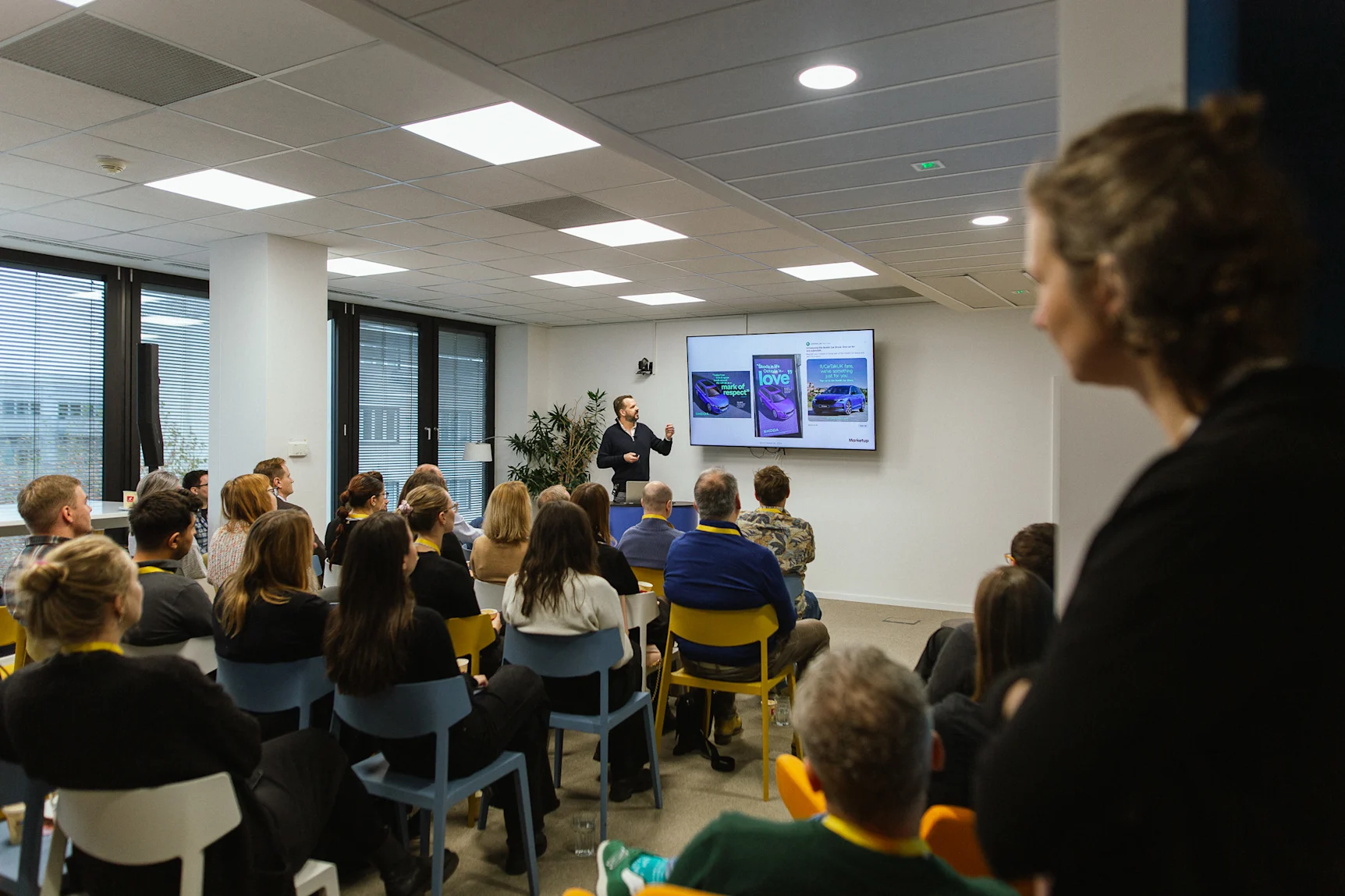Michal Čížek
19. 11. 2024
Read more
Connected TV, Reddit, Creative B2B: Marketing Inspiration for 2025
27. 11. 2024


What will you see if you open LinkedIn before the end of the year? If you're in marketing, then apart from the current case of Jaguar (this is the last mention, I promise), it will probably be Christmas campaigns or trend reports forecasting what 2025 will be like from a marketer’s perspective. But trends should also be approached with caution.
If we look at the time around the Covid-pandemic, which significantly accelerated digital transformation, there was a lot of talk about a "new normal". In e-commerce, we heard terms like “direct-to-consumer (D2C) revolution”, with brands selling to end customers without additional intermediaries or third-party distribution. According to eMarketer's research, D2C sales growth reached 37% in 2019 in the US alone, hitting the 40% mark the following year.
Apparently, these numbers inspired the new CEO of a major American sports brand. A decision was made: the future clearly belongs to D2C. All activities, especially marketing, would need to follow the aim to become a D2C leader. Brand building? From now on, according to the management, there was no need. At the end of the day, the brand was already well-known. And if D2C sales were to be reinforced, the assumption was that investment was needed, with performance marketing aimed at immediate sales being a priority.
Similarly, the focus of marketing activities shifted from the acquisition of new customers to serving existing ones. The brand was able to benefit from its historically strong position, whereby the management's idea was that the existing customer base would provide the company with further growth in an easier and more cost-effective way. Ultimately, communications could leverage owned media such as email or mobile apps. The third strategic decision was to get rid of product categories: perhaps to allow every existing customer to buy everything, encouraging cross-sell and up-sell.
Did the new approach work? In the first years after the new model was set up, the new way seemed to be a real success. Celebratory headlines began to appear in the media about how the brand responded radically to changing market conditions and took advantage of current market trends. Yes, you may have already guessed that we’re talking about Nike.

When you think of Nike, creative and emotional campaigns such as Dream Crazy and Dream Crazier may be top-of-mind. Most of the time, the brand is put in the limelight, not its products. However, with the shift in strategy, the brand's marketing communications started to focus more and more on product communication and promotional offers. Discounts for "members" became the main incentive. And if a 25% discount doesn't work, then maybe let’s try 50%?

Today, we know that all the decisions described above go against the principles of evidence-based marketing: the performance part of marketing communications works mainly with customers who are ready to buy – it therefore works as a short-term stimulant, which will hit its limits in the long run. And addressing the decline in interest by increasing discounts is problematic, to say the least.
Serving existing customers is of course important. But even with big and popular brands like Nike, it’s not enough to focus on brand fans. Unfortunately, most shoppers have a rather lukewarm relationship with brands in general, and if their favourite brand is not available in stores, it's easy to reach for a competitor’s offer.
It is therefore not surprising that after a promising start, growth has slowed significantly, hitting negative numbers by 2024.

Nike's new CEO, who has been associated with the brand all his professional life, understood that the situation had to change. Brand building based on emotion and storytelling was back on the agenda. Nike unveiled a new campaign called Winning Isn’t for Everyone.
https://www.youtube.com/watch?v=pwLergHG81c

Did it bring the much-needed turnaround? Admittedly, it had a number of important ingredients: it was bold, built on strong stories, focused not just on products but on the brand, and it had a clear point of view.
But there was one fundamental flaw that the public quickly sensed. Nike has a very interesting mission: whilst other brands often slip into corporate statements that neither offend nor excite anyone, Nike defined its mission as to “bring inspiration and innovation to every athlete in the world”, whereby if you have a body, then you are considered an athlete. And while Nike has done well in the past to combine this mission with its communications that infused the “Just do it” tagline with meaning, the new campaign was a different case.
It seemed to go directly against this message – as if Nike were saying that some athletes are privileged while others are not supposed to even think of winning. Even without a thorough analysis, it was clear that there was a misalignment of the communication with the brand DNA, and the negative sentiment of comments on YouTube seems to confirm this.

However, another proof is System1's testing, where the long-term potential of the campaign in particular was rated as poor with 1.5 stars, below the category average of 2.4 stars.

So, what’s the key takeaway? Going back to brand building is the right step, but we shouldn’t forget about the brand DNA. And what about trends then? A quote attributed to a few personalities at once, whether it's physicist Niels Bohr or baseball player Yogi Berra, may come in handy: “Never make predictions, especially about the future.” Marketing history (and arguably the present) is full of false prophecies: from identifying D2C as a revolution to repeated rumors of the end of TV commercials or broadly targeted communications, or even radical industry change. For example, the “father of positioning” Al Ries and his daughter Laura predicted the fall of advertising and the rise of PR – only to subsequently work on a book that claims the exact opposite.
Does this mean that we shouldn't pay much attention to trends? Not really. Rather, it's better to take an “exploit & explore” approach: leverage strong existing foundations while experimenting with innovations. What are some trends to consider and explore for 2025 then?
Discovering overlooked platforms: Reddit
When Reddit went public not long ago, Scott Galloway, marketing professor at NYU Stern and founder of Section, pointed out an interesting fact: it’s a massively undervalued company when comparing traffic to its market capitalisation.

Resource: Scott Galloway
"Figuring out the monetization is hard," he wrote. “Developing a product that commands this level of attention is harder, and Reddit has done it.” Globally, Reddit already claims half a billion users. By 2028, it expects to grow by another 50 million, according to Statista data.
Reddit mentions that most of its audience is male and younger. From the advertisers' point of view, there’s an interesting opportunity to reach their audiences, especially since the terms are set interestingly so far given the low saturation: in European markets, the CPM is around 50 cents and the CPC is still some cents cheaper.
A full 63% of users, according to Reddit, say that they’re open to brands communicating on the platform. However, they expect brands to tailor communication to the platform’s environment. An interesting example in this regard can be a campaign by Škoda UK. Instead of starting to clutter the space with banners, it has based its approach on listening to the community first.
On the massive automotive forum CarTalkUK, Škoda invited fans to help create slogans for the Octavia model. The best ones were then used in an integrated campaign. As a thank-you, Škoda then organised a roadshow around the UK, visiting Reddit fans and offering them a test drive.

But the work did not stop there. In an unplanned next step, Škoda responded to a user spontaneously suggesting a special edition based on a vote on Reddit. Agility is key, and the brand’s quick positive response made it possible to introduce a Škoda Octavia “Redditor Edit” to the public.

“It showed us how to engage fans in the right way," says Kirsten Stagg, marketing director at Škoda UK, about the campaign. “Not just to build credibility but also to deliver a creative and original campaign that is bang-on Škoda’s human tone of voice.”
Video wins: the rise of video content and Connected TV
Perhaps no trend report can miss the constant growth of video content. According to WeAreSocial and Meltwater, YouTube boasts 2.5 billion active users worldwide, showing a growth of 1 billion since 2016. What is important in this context is that YouTube content is increasingly consumed not only on mobile phones, tablets and computer monitors, but also on TV screens – thus becoming a competitor not only for other digital platforms, but also for usual TV programmes.
Traditionally, video content has been seen as particularly suited to the top of the marketing funnel (provided we accept this simplification) – meaning mainly emotional messages and big campaigns. However, along with its growing popularity, it turns out that different video formats can work well across the entire customer journey, as the following graphic illustrates:

One brand that has understood the importance of working with video content is Samsung. Its “Flipvertising” campaign can provide inspiration on how to approach video in a creative way as part of a larger communications initiative.
https://www.youtube.com/watch?v=_XKtKqa4voE
The growing importance of video content also reflects the growing interest of advertisers worldwide. According to WARC, in 2018 brands invested $12 billion in YouTube; in 2024, the investment level is expected to be $33.5 billion. Similarly, investments in Connected TV (in simple terms TVs connected to the internet using streaming content from the internet) increased from $8.7 billion in 2018 to almost $30 billion in 2024. Even so, CTV is still an under-appreciated medium that presents serious competition to traditional (linear) TV, especially with the growth in popularity of Over the Top (OTT) services, i.e. streaming platforms like Netflix. This attractiveness is compounded by the constant media inflation, with the price of advertising space on linear TV rising by more than 10% per year.

In addition to the competitive advantage for those brands that start using CTV now, the new way of TV broadcasting offers other benefits. These include the possibility of programmatic buying, the use of data-driven targeting, and the incorporation of direct-response elements, such as QR codes or click-through options using the viewer’s remote control.
Creativity in B2B: it's not Boring to Boring
Marketing communication in B2B has long been thought to be subject to completely different rules than B2C communication. But along with the education of marketers, the situation is starting to change: according to LinkedIn’s B2B Benchmarks 2024 research, nearly 70% of marketers say they have increased their brand investment. Nearly 90% claim that they’re advocating bolder, more creative campaigns in B2B as well. This makes sense, as research confirms that even in B2B, emotional communication with a single-minded message, appealing to recipients' intuition, is more effective than persuasion through rational arguments. Could 2025 be the year when we see the application of the "evidence-based" approach in B2B as well? Let’s see.
When it comes to communication channels used in B2B, it’s probably not surprising to see social media in the lead with a usage of 75% (and LinkedIn plays a key role here). This is followed by email with 61% and blogs with 42%. But next up is the aforementioned Connected TV, which is already used by 20% of B2B marketers. Nearly 6 in 10 are planning to increase their investment in the next year, with data-driven targeting capabilities making CTV an ideal platform for B2B communications as well.
When it comes to personalisation and targeting, two debated and somewhat controversial topics, we can take inspiration from Spotify’s campaign to showcase these aspects of the platform to CMOs of large brands.
https://www.youtube.com/watch?v=v6Q7qBjqgT8&t=1s
2025 and the future of marketing communications: it’s definitely not just about following trends. It turns out that abandoning tried and tested principles of brand building and effective marketing communications bears a considerable risk, while it can pay off to start experimenting with new platforms, video content and Connected TV as well as creative B2B campaigns. And one final note: we are of course ready to help you with all these topics, or organise a workshop tailored specifically to your brand.


